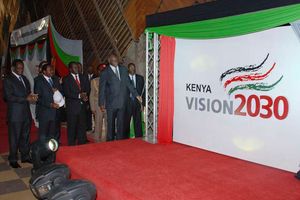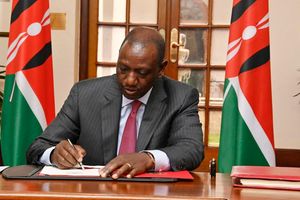
National Health Insurance Fund headquarters in Nairobi on November 22, 2023.
Policy intent and actual effects are almost always different. That is why lawmakers have to answer the question, what mischief are we trying to cure? It is the reason every bill must publish a memorandum of objects and reasons. Why are you making this law?
Policy is often about incentivising behavior. A good example is promoting the desired behavior such as saving and investing. Or discouraging undesirable behavior – say alcohol and drug abuse. Let us examine effects of a few policy examples – subsidised fertilizer, fight against illicit brews, housing levy, eurobond payment, compulsory social health insurance fund, and railway revival.
But first a cautionary word. There is no such thing as neutral policy. There are always losers and winners. Generally, the question is whether the wins or gains are more than sufficient to compensate the loses. But how does such compensation happen in practice? This question goes unanswered far too many times, and with disastrous consequences.
One such failure was the redistribution question in Sessional Paper Number 10 of 1965. The argument went thus: since we don’t have adequate resources, let’s start with high potential areas, for quick returns. The income gained from that choice will then be applied to areas of low potential.
Sounds reasonable. In practice it was anything but. Large swathes of the republic remained unattended for a long time, leading to serious inequalities. The structure of the economy remained colonial. Something had to give. The cataclysm came in 2007/8. High octane politics left 1,300 citizens dead. A new Constitution created the equalization fund and devolution to cure that inequality.
Subsidised fertilizer is not a new policy. The Kenya Kwanza regime has, however, turned it into a sacred cow, never to be questioned. Such an environment leads to governance failures and corruption. Enter fake fertilizer.
Curbing illicit brews is another old idea. The Grand Coalition government encouraged brewers to make affordable, regulated alcohol. Both Keroche and EABL responded with several brands. Craft brewers emerged. But taxation has discouraged such brewers. The administration has turned to closing bars and arresting alcohol makers. They recently had a brainwave to help them along. Public servants cannot own bars and restaurants! Good luck with that.
When the housing levy was ruled discriminatory for focusing on the salaried, the regime’s solution was to make it apply to all Kenyans, including the non-salaried. Trouble is, how do you determine the income of the non-salaried hawker, boda-boda operator or farmer?
The invasion of Ukraine, led to high food and fuel prices, at a time when US interest rates were high and rising, and a large US$2 billion eurobond payment was looming. The ensuing speculation of a possible default on the bond, led to a major (36 per cent) depreciation of the shilling against the US dollar.
The eurobond situation was resolved. But only by issuing a new more expensive eurobond, setting up the inevitable bigger crisis a few years down the line. As a result, the run on the shilling has been stemmed, a positive outcome. Price adjustments are, however, sticky downwards. The shilling seems settled at around 135 to the dollar for now, about a 15 per cent depreciation from its 2022 level.
Wild currency swings create economic instability. The Asian financial crisis last decade was, in part, the result of exchange volatility. It makes planning very difficult. Just now, the improvement in the exchange rate has led to slightly lower fuel prices. But investments have slowed down.
The Ministry of Health has maintained for several years, that the National Hospital Insurance Fund was not viable because the voluntary pool was not making money. The voluntary pool comprises the non-salaried. The ministry complains that they only pay when they get sick. Before Covid-19, the Ministry was looking for ways to make everyone pay.
Making health insurance compulsory is harder than it sounds. Where do you find the informal sector in order to make them pay? Empirical evidence suggests that like their predecessors, the KK regime have gone the wrong direction on this matter. A pilot by the NHIF and the Laikipia Health Service brought 63 per cent of the county population into NHIF within three months. That is the highest recorded in any county.
The pilot solved the real problem with the old NHIF – a business model that made it incredibly expensive for the informal sector to pay the premium. Based on branch offices, the model forced citizens to travel to where the branches were. In the Laikipia example, a customer could spend Sh1,000 on fare alone, and spend a day, to go to Nanyuki to pay the monthly premium of Sh500 – a ridiculous situation.
The pilot simply made it possible for the Community Health Volunteers (now Promoters) to use Mjali on mobile phones to register households to NHIF. The later allowed instalment payments of the premium, so citizens could pay as they got their irregular income. The current SHIF registration has no payment option. Rather the household head simply answers yes or no as to whether they have health insurance! Go figure!
Unintended consequences of policy actions are not always negative. Here is one to make you smile. The revived Nanyuki meter-gauge line was primarily intended for cargo, with fuel products as the anchor. Kenya Railways (KR) got help from KDF and the National Youth Service to repair it. Within four months, the line was up. KR teamed up with counties to publicize the whole affair. Connecting dots, the national government decided to link the Standard Gauge to the meter gauge at Longonot, and revive the old Kisumu line.
KR reports that 165,784 passengers travelled on the two lines last year, with 97,000 using the Nanyuki line!
@NdirituMuriithi is an economist










